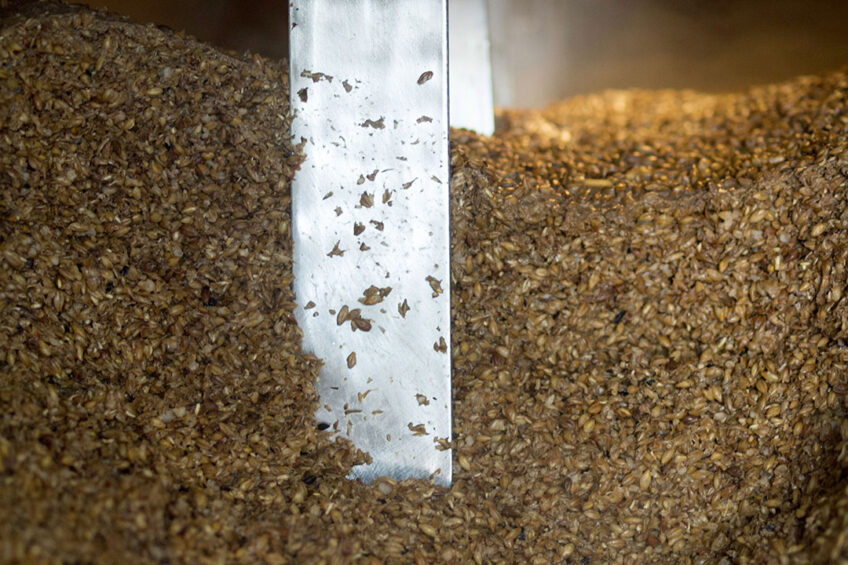Using Brewer’s spent grains and agricultural residues in pig feed

Germany produces just under 100m hectolitres of beer every year resulting in approximately 1,860 metric kt of Brewer’s Spent Grains (BSG). A small proportion is produced as food-grade by-product, but much is given away to local farmers.
However, due to a water content of approximately 80% and the presence of nutrients, it is a rapidly perishable product. Inoculating BSG with lactic acid bacteria creates more scop for microbiologically safe processing, while fermentation can increase soluble sugar and protein contents, thus increasing its nutritional value.
BSGs use in livestock feed
BSGs have been used as feed for various animals, including pigs, chickens, lambs and cows with limited success, but researchers wanted to further foster the use of BSGs and agricultural residues in feed formulation, looking at their potential as ingredients for animal nutrition.
BSG-raw matrix improved
The BSG-raw matrix was technologically and functionally improved by adding other natural active ingredient carriers (crushed wheat, rapeseed and pumpkin seed press cake) to improve the nutritional and energetic values of feed and using the possibilities of planetary roller extrusion as a technique to produce feed blends. The developed formulations were provided to pigs in addition to organic quality basic feed.
Extrusion of the ensiled BSG was carried out using a planetary roller extruder. About 10kg of ensiled BSG per hour were fed to the extruder via a continuously operating feeder and processed via 2 roller section modules about 65C and 2 bar. The temperature was chosen to maintain the nutritional quality. 2 BSG-extrudates containing 30% BSG silage, 55% crushed wheat and 15% rapeseed press cake (BSG1) or 15% pumpkin seed press cake (BSG2) were produced. Crushed wheat and press cakes wee used to improve the taste as pure BSGs were not accepted by pigs in an earlier study. The moisture content was at least 31%.
Feeding trial
A total of 60 pigs at 28 days of age were used with live weights of between 6.3kgs and 12.3kgs. Until 30kgs live weight was reached, the pigs were fed on rearing fodder, before moving to pre-fattening fodder and then at 75kgs final fattening fodder. The feeding experiment started at 42 days in a conventional barn with slatted floors with straw.
The control group (CG) as well as the experimental groups – G1 and G2 – consisted of 20 pigs each. Organic quality basic feed was given ad-libitum in feed troughs for the 3 groups. The BSG-based extrudates were offered to G1 and G2 as additional feed at a ratio of 1:10. The amount of BSG-based feed offered was increased to 10g per animal on a weekly basis from 40g at week 1 to 100g at week 7 and remained constant until the end of the trial at 189 days.
Results
Due to different growth rates of the animals, the pigs were slaughtered over a period of time with a total of 46 out of the 60 animals slaughtered the end of the feeding trial. Animals which had not reached 120kgs by this stage were no longer included in the evaluation.
One of the objectives of the trial was to assure the extruded feeds (BSG1 and BSG2) had a similar metabolizable energy content of 13-15 MJ kg as found in the organic quality basic feed, which they both did. However, the protein contents of the extruded feeds were higher – 14.7% and 20.8%, while the starch content was 43% in both BSG1 and BSG2 and comparable to rearing fodder but 85 less than the content in pre-fattening fodder. Fat analysis revealed a higher fat content in BSG1 and BSG2 than in either rearing and pre-fattening fodder.
The crude fibre content, which plays an important role in safety and intestinal health, was increased in BSG1 compared with BSG2. However, both only contained half of the ADF content of the organic quality basic feed. BSG1 had a NDF content which was comparable to the organic quality basic feed while the content in BSG2 was reduced. But the overall compositions of BSG1 and BSG2 wee not statistically different to the organic basic feed applied.
Further feeding trial
As the results were seen as encouraging, a further feeding trial took place. The 2 extrudates were supplied together with the organic quality basic feed in a weight-based ratio of 1:10. The feed with BSG1 was always completely eaten after a habituation period of 10 days. At the beginning, the 20 animals fed with BSG2 did not finish their daily portion, but this behaviour changed and after 12 weeks pigs started to finish their daily portion. In total the group with BSG1 ate 299kg and the group with BSG2 216kgs of additional feed throughout the feeding period.
It was shown that processed BSG and agricultural residues can be used in pig feed formation. Less feed is needed that would also be suitable for human nutrition. The BSG-based feed formulations did not result in negative effects on meat quality and the animals remained in good health. However, the higher fibre content of the BSG-based feed and consequently faster saturation may potentially affect the weight gain.
Nevertheless, the team felt it could be concluded that BSG and agricultural residue-based feeds can be used to supplement part of ground fodder, which will eventually result in reduced waste formulation.
The study, Utilisation of Brewer’s Spent Grains and Agricultural residues in Pig Feed Formulation, was published in the journal Sustainability and led by the Institute for Food and Environmental Research, with support from other academic institutions in Germany.











